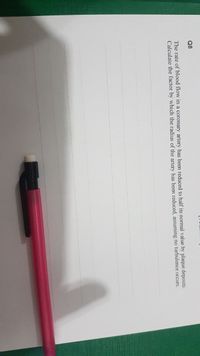
College Physics
11th Edition
ISBN: 9781305952300
Author: Raymond A. Serway, Chris Vuille
Publisher: Cengage Learning
expand_more
expand_more
format_list_bulleted
Question

Transcribed Image Text:Q8
The rate of blood flow in a coronary artery has been reduced to half its normal value by plaque deposits.
Calculate the factor by which the radius of the artery has been reduced, assuming no turbulence occurs.
Expert Solution
This question has been solved!
Explore an expertly crafted, step-by-step solution for a thorough understanding of key concepts.
Step by stepSolved in 2 steps

Knowledge Booster
Learn more about
Need a deep-dive on the concept behind this application? Look no further. Learn more about this topic, physics and related others by exploring similar questions and additional content below.Similar questions
- The heart of a resting adult pumps blood at a rate of 5.00 L/min. (a) Convert this to cm/s. (b) What is this rate in m/s?arrow_forwardThe heart of a resting adult pumps blood at a rate of 7.14 L/min. (a) Convert this to cm3/s. (b) What is this rate in m3/s?arrow_forwardThe following is a practice question for an upcoming test: At a resting pulse rate of 77 beats per minute, the human heart typically pumps about 73 mL of blood per beat. Blood has a density of 1060 kg/m3. Circulating all of the blood in the body through the heart takes about 1 min for a person at rest. On average, what mass of blood does the heart pump with each heart beat in kg? mass per heart beat:arrow_forward
- Although human lung capacity is about 3 liters per lung, the tidal volume, representing the amount of air that is breathed in and out with each breath is much -3 less, typically about 250 cm7 per lung. The cycle of inhalation and exhalation during normal activity can be represented as a sine curve, as shown in the figure below, where the amount of air in each lung before inhalation begins is about 1.09 liters (the functional residual capacity of the lung) and the time on the horizontal axis has been calculated with the average adult breathing rate of 16 breaths per minute. Volume of air in lungs (L) 1.34 1.09 mm minimum height maximum height 15 We can model each lung as a cylinder of radius 5.95 cm in which one end cap is free to move up and down, increasing and decreasing the volume of the model lung during the breathing process. (a) Using the data above, calculate the minimum and maximum heights (in cm) of the model lung during the breathing process. (Round your answers to at least…arrow_forwardThe heart of a resting adult pumps blood at a rate of 6.94 L/min. (a) Convert this to cm3/s. (b) What is this rate in m3/s?arrow_forwardIf the flow rate of the blood flowing through an artery of 16 mm diameter is 90.5 cm3/s, the average speed of the blood flow isarrow_forward
- The left ventricle stroke rate is 94 mL and the heart rate is 70 BPM, calculate the blood flow in L min-1 to 1 decimal place.arrow_forwardDetermine the erythrocyte sedimentation rate assuming that the erythrocytes have a spherical shape with a diameter of 8 microns. Take the blood density 1060 kg/m3, the density of the substance of erythrocytes 1090 kg/m3.arrow_forwardIf you are infusing a 1 L Iv bag of a normal saline at a rate of 100 ml per hour, how long will it take for the entire IV bag to infuse into the patient ?arrow_forward
arrow_back_ios
arrow_forward_ios
Recommended textbooks for you
 College PhysicsPhysicsISBN:9781305952300Author:Raymond A. Serway, Chris VuillePublisher:Cengage Learning
College PhysicsPhysicsISBN:9781305952300Author:Raymond A. Serway, Chris VuillePublisher:Cengage Learning University Physics (14th Edition)PhysicsISBN:9780133969290Author:Hugh D. Young, Roger A. FreedmanPublisher:PEARSON
University Physics (14th Edition)PhysicsISBN:9780133969290Author:Hugh D. Young, Roger A. FreedmanPublisher:PEARSON Introduction To Quantum MechanicsPhysicsISBN:9781107189638Author:Griffiths, David J., Schroeter, Darrell F.Publisher:Cambridge University Press
Introduction To Quantum MechanicsPhysicsISBN:9781107189638Author:Griffiths, David J., Schroeter, Darrell F.Publisher:Cambridge University Press Physics for Scientists and EngineersPhysicsISBN:9781337553278Author:Raymond A. Serway, John W. JewettPublisher:Cengage Learning
Physics for Scientists and EngineersPhysicsISBN:9781337553278Author:Raymond A. Serway, John W. JewettPublisher:Cengage Learning Lecture- Tutorials for Introductory AstronomyPhysicsISBN:9780321820464Author:Edward E. Prather, Tim P. Slater, Jeff P. Adams, Gina BrissendenPublisher:Addison-Wesley
Lecture- Tutorials for Introductory AstronomyPhysicsISBN:9780321820464Author:Edward E. Prather, Tim P. Slater, Jeff P. Adams, Gina BrissendenPublisher:Addison-Wesley College Physics: A Strategic Approach (4th Editio...PhysicsISBN:9780134609034Author:Randall D. Knight (Professor Emeritus), Brian Jones, Stuart FieldPublisher:PEARSON
College Physics: A Strategic Approach (4th Editio...PhysicsISBN:9780134609034Author:Randall D. Knight (Professor Emeritus), Brian Jones, Stuart FieldPublisher:PEARSON

College Physics
Physics
ISBN:9781305952300
Author:Raymond A. Serway, Chris Vuille
Publisher:Cengage Learning

University Physics (14th Edition)
Physics
ISBN:9780133969290
Author:Hugh D. Young, Roger A. Freedman
Publisher:PEARSON

Introduction To Quantum Mechanics
Physics
ISBN:9781107189638
Author:Griffiths, David J., Schroeter, Darrell F.
Publisher:Cambridge University Press

Physics for Scientists and Engineers
Physics
ISBN:9781337553278
Author:Raymond A. Serway, John W. Jewett
Publisher:Cengage Learning

Lecture- Tutorials for Introductory Astronomy
Physics
ISBN:9780321820464
Author:Edward E. Prather, Tim P. Slater, Jeff P. Adams, Gina Brissenden
Publisher:Addison-Wesley

College Physics: A Strategic Approach (4th Editio...
Physics
ISBN:9780134609034
Author:Randall D. Knight (Professor Emeritus), Brian Jones, Stuart Field
Publisher:PEARSON